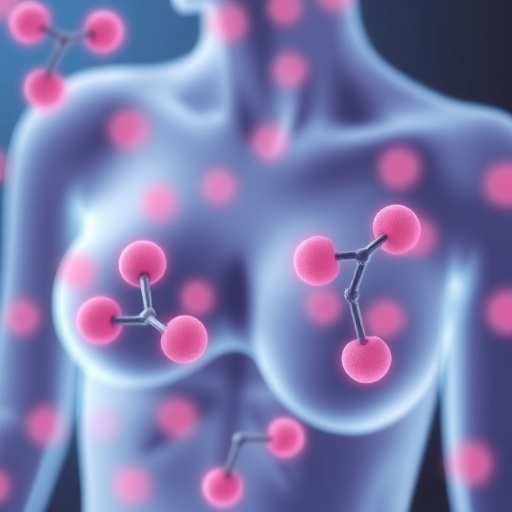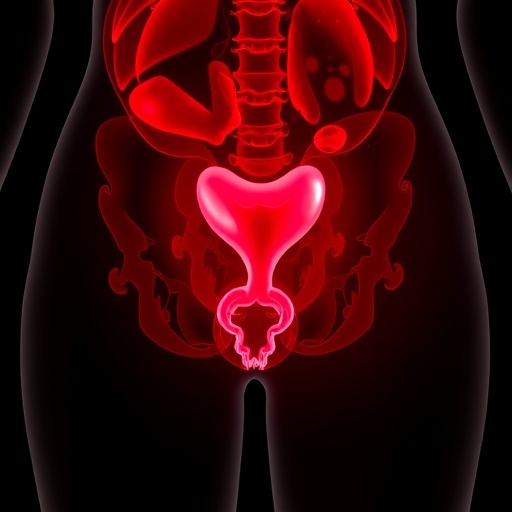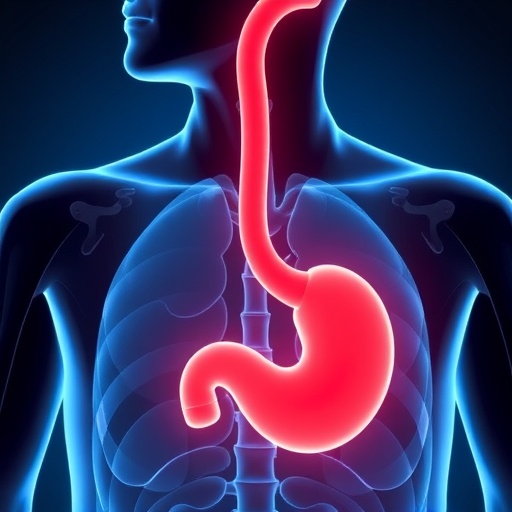In a groundbreaking study poised to advance breast cancer treatment, researchers have identified promising novel aromatase inhibitors derived from phytochemicals, offering a fresh therapeutic avenue beyond existing drugs. Breast cancer remains a formidable challenge worldwide, largely driven by the overproduction of estrogen and the interaction of this hormone with its receptors. Central to this hormonal biosynthesis pathway is the enzyme aromatase (CYP19A1), which catalyzes the conversion of androgens to estrogens. Targeting aromatase has become a cornerstone in breast cancer therapy, but current inhibitors such as Letrozole come with drawbacks like side effects and the development of drug resistance, motivating the urgent search for safer and more effective alternatives.
In this meticulous investigation, the research team explored the phytochemical landscape of Ricinus communis, a medicinal plant known for its bioactive compounds. They retrieved 72 distinct phytochemicals from this species and subjected them to an in-depth, structure-based virtual screening against the aromatase enzyme, utilizing advanced computational methodologies. This approach leveraged AutoDock Vina within the PyRx platform to dock each compound to the high-resolution crystal structure of aromatase (PDB ID: 3EQM), allowing precise estimation of binding affinities.
The computational screening revealed that out of 72 candidates, ten phytochemicals exhibited stronger binding affinities towards aromatase than the benchmark compound Letrozole, which had a docking score of −8.3 kcal/mol. Standing out among these, Stigmasterol, Fucosterol, and 7-oxo-β-sitosterol demonstrated remarkable docking scores of −10.5, −10.2, and approximately −9.3 kcal/mol respectively. These results not only suggest superior inhibition potential but also highlight the structural uniqueness of these molecules in interacting with the enzyme’s active site.
Delving deeper into the molecular interactions, the study illustrated that these top hits engage aromatase via key hydrophobic contacts and robust hydrogen bonding with critical residues such as MET374, ALA306, and TRP224. These interactions are pivotal for anchoring the inhibitors effectively within the enzyme’s catalytic domain, thereby potentially impeding estrogen biosynthesis more efficiently. The visualization of binding poses provided compelling insights into how these phytochemicals fit snugly into the active site pocket, enhancing the plausibility of their inhibitory action.
Understanding that binding affinity alone does not guarantee therapeutic viability, the researchers rigorously evaluated the drug-likeness properties of these compounds using Lipinski’s rule of five. Impressively, all three compounds satisfied the stringent criteria for oral bioavailability, signaling favorable physicochemical properties conducive to drug development. Such compliance indicates a promising balance between molecular size, lipophilicity, and hydrogen bonding potential, all critical for effective absorption and distribution.
Moreover, to anticipate the pharmacokinetic and toxicity profiles, comprehensive ADMET (Absorption, Distribution, Metabolism, Excretion, and Toxicity) analyses were conducted through tools like SwissADME, admetSAR 2.0, and pkCSM. Encouragingly, these compounds exhibited predicted high intestinal absorption, low toxicity risks (non-carcinogenic), and minimal interference with cytochrome P450 enzymes, highlighting a safety profile superior to many existing treatments. This multidimensional profiling underscores their potential as safe candidates for further preclinical development.
A hallmark of this study is its incorporation of molecular dynamics (MD) simulations, a technique that reveals the stability and behavior of protein-ligand complexes over time. Employing GROMACS for 100-nanosecond simulations, the researchers tracked parameters including root mean square deviation (RMSD), root mean square fluctuation (RMSF), radius of gyration, and the number of hydrogen bonds. These metrics collectively demonstrate that the complexes formed by Stigmasterol, Fucosterol, and 7-oxo-β-sitosterol are remarkably stable, maintaining consistent interactions without significant structural disruptions throughout the simulated timeframe.
The stability observed in MD simulations bolsters the docking results by confirming that these inhibitors are not only strong binders but also form durable complexes with aromatase under dynamic physiological conditions. The consistent hydrogen bonding observed further supports their sustained engagement with the enzyme, a critical factor for long-term inhibition efficacy. This dynamic insight bridges the gap between static docking predictions and real biological environments.
Collectively, this comprehensive in silico framework positions these three phytochemicals as compelling candidates for next-generation aromatase inhibitors. Their superior binding properties, compliance with drug-likeness criteria, favorable ADMET profiles, and demonstrated dynamic stability project them as potent and safe alternatives to conventional drugs like Letrozole. The study’s findings resonate deeply within the oncology and pharmaceutical communities, promising to catalyze further experimental validation.
Looking ahead, the authors emphasize the necessity of translating these computational findings into laboratory settings through robust in vitro and in vivo evaluations. Such follow-up studies are critical to confirm the bioactivity, efficacy, and safety of these compounds in cellular and animal models before contemplating clinical trials. The encouragement for this translational research stems from the urgent clinical need to expand the arsenal against hormone-responsive breast cancer.
Importantly, the identification of these phytochemicals reinforces the value of natural products as a rich reservoir for drug discovery, especially in oncology. Harnessing compounds from medicinal plants like Ricinus communis can revolutionize cancer therapeutics by offering novel scaffolds with potentially fewer side effects and mitigated resistance issues that plague synthetic drugs. This aligns with the growing paradigm of integrating traditional medicinal knowledge with cutting-edge computational drug design.
The integration of molecular docking, pharmacokinetic modeling, and molecular dynamics simulations in this research exemplifies the power of computational techniques in accelerating drug discovery. Such multidisciplinary approaches allow researchers to triage vast compound libraries efficiently, predict pharmacological properties, and visualize molecular interactions with atomic detail. This study serves as a blueprint for future natural product-based drug development pipelines.
In conclusion, this seminal research underscores a promising advancement in the pursuit of effective breast cancer therapeutics. By pinpointing Stigmasterol, Fucosterol, and 7-oxo-β-sitosterol as potential novel aromatase inhibitors with superior docking affinities and favorable pharmacokinetic profiles compared to existing drugs, the study illuminates new hopes for patients battling hormone-driven malignancies. The promising computational evidence lays groundwork essential for experimental validation and eventual clinical exploration.
As the prevalence of breast cancer continues to pose global health challenges, breakthroughs such as this hold the potential to transform therapeutic strategies. The fusion of natural product chemistry with high-precision computational biology heralds a new era in designing safer, more efficient drugs that can overcome the limitations of current treatments. The future of breast cancer care may well be rewritten by the bioactive phytochemicals concealed within nature’s molecular repertoire.
The scientific community and clinicians alike will keenly watch subsequent experimental studies stemming from this work, eager to verify the translational potential of these novel candidates. Should laboratory and clinical trials confirm their efficacy and safety, these phytochemicals could redefine aromatase-targeted therapy, ushering in enhanced treatment outcomes and improved quality of life for countless patients worldwide. This study is a landmark contribution to contemporary cancer pharmacology and a testament to the enduring promise of integrating traditional natural compounds with modern technological innovation.
Subject of Research: Novel phytochemical aromatase inhibitors targeting breast cancer
Article Title: Identification of potential novel aromatase inhibitors as therapeutic strategies against breast cancer: insight into molecular docking, MD simulations and ADMET profiling
Article References:
Ojedele, O.A., Hamdi, N., Mughram, M.H.A. et al. Identification of potential novel aromatase inhibitors as therapeutic strategies against breast cancer: insight into molecular docking, MD simulations and ADMET profiling. BMC Cancer (2025). https://doi.org/10.1186/s12885-025-15321-3
Image Credits: Scienmag.com
DOI: https://doi.org/10.1186/s12885-025-15321-3
Tags: aromatase enzyme CYP19A1binding affinity estimation in drug discoverybreast cancer treatment advancementscomputational drug design techniquesdrug resistance in breast cancer therapyestrogen overproduction in breast cancerinnovative approaches in oncology researchnovel aromatase inhibitorsphytochemicals in cancer therapyRicinus communis bioactive compoundssafer alternatives to Letrozolestructure-based virtual screening methods





